The Campaign Definition and Maintenance screen displays, as shown below.

The Campaign Definition screen enables you to define and maintain various fundraising campaigns and link them with appeals, funds, products, solicitation teams, marketing lists, prospects, and recognition levels. Organizations use this screen to focus the fundraising structures by campaigns. Some examples of campaigns include New Building Capital Campaign or General Campaign.
To define a campaign:
1. Select Fundraising Setup > Fundraising Launch on the toolbar.
2. Select Maintain Campaigns from the Fundraising Setup task category.
3. Click
Add.
The Campaign Definition and Maintenance screen displays, as shown below.

4. Enter the Campaign name.
 When entering
the campaign name, if you tab out of the field and the name is removed,
you have entered an invalid code. Campaign names cannot contain special
characters or spaces.
When entering
the campaign name, if you tab out of the field and the name is removed,
you have entered an invalid code. Campaign names cannot contain special
characters or spaces.
5. Enter the campaign Description.
6. Select the Campaign Class from the drop-down.
7. Click the Parent Campaign link and search for a parent campaign, if necessary.
8. Select the Recognition Structure, if necessary.
9. Enter the Goal Amount.
10. Select the Begin Date and End Date of the campaign, if necessary.
11. On the
Linked Donation Codes tab, review the products linked to the campaign,
as shown below.
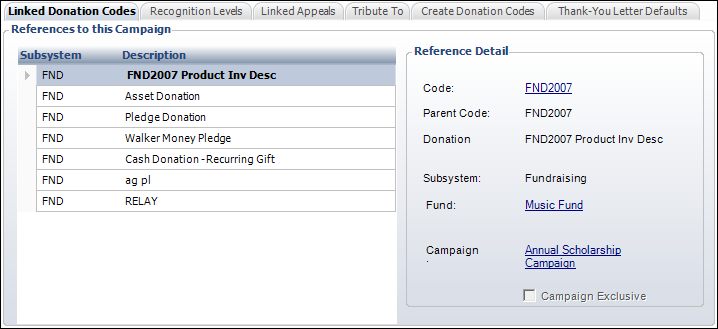
This includes donations and pledges entered into the system or combined
with products related to the campaign. If this is a new campaign, then
no linked donations display.
 Double-click
a product to open it in the Gift
Code Maintenance screen.
Double-click
a product to open it in the Gift
Code Maintenance screen.
12. On the
Recognition Levels tab, review the fundraising campaign recognition levels
for the association, as shown below.
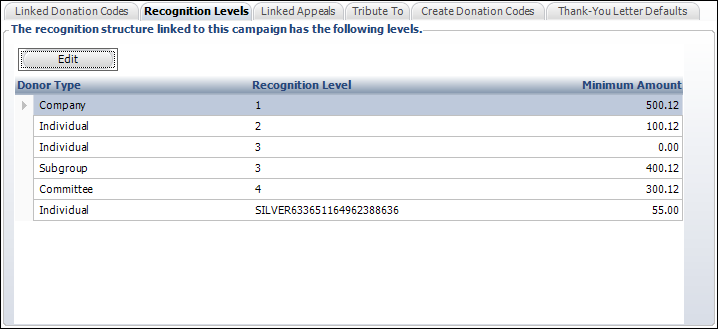
Highlight a record and click Edit to open
it in the Recognition Structure for Fundraising screen. For more information,
please see Defining Recognition Structures.
13. On the
Linked Appeals tab, review the appeals linked to the campaign, as shown
below.
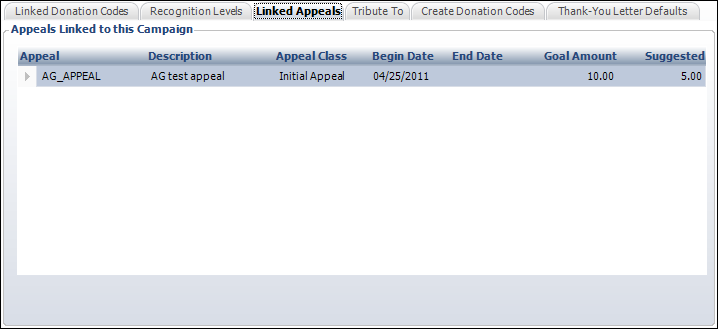
 The appeal
must first be defined on the Appeal Definition
and Maintenance screen before it displays here.
The appeal
must first be defined on the Appeal Definition
and Maintenance screen before it displays here.
14. On the
Tribute To tab, perform the following to add a tribute element to the
campaign, as shown below.
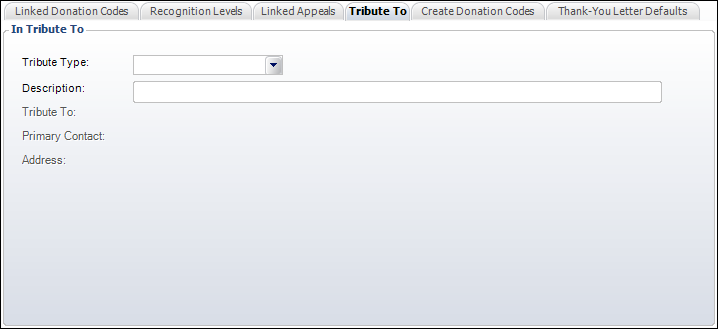
a. Select the Tribute Type from the drop-down.
b. Enter the Description of the tribute.
c. Click the Tribute To link and search for a customer who this campaign is a tribute to.
d. Click the Primary Contact link and search for a customer who is the primary contact for the tribute.
15. Click
Save to enable the Create Donation Codes tab,
as shown below.
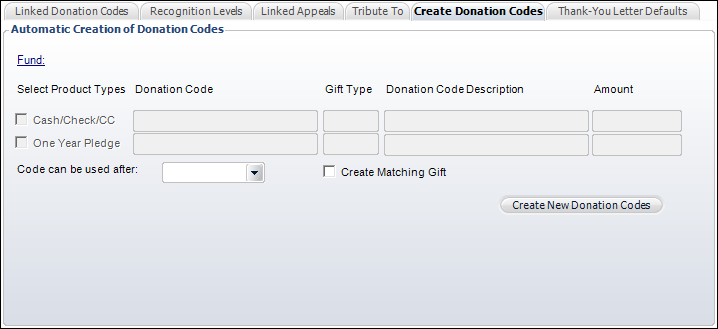
16. On the Create Donation Codes tab, perform the following to automatically create gift products:
a. Click the Fund link to search for a related fund.
b. Select
whether the funds will be placed through Cash/Check/CC or
through a One Year Pledge.
The default product for the fund displays.
c. Enter the Amount.
d. If necessary, select the date to start taking gifts on from the Code can be used after drop-down.
e. If necessary, check the Create Matching Gift checkbox.
f. Click
Create New Donation Codes to commit the
gift products.
A pop-up displays stating the “Gift Product was created successfully.”
17. On the
Thank You Letter Defaults tab, perform the following to select default
letters to use to create thank you letters for this Fund:
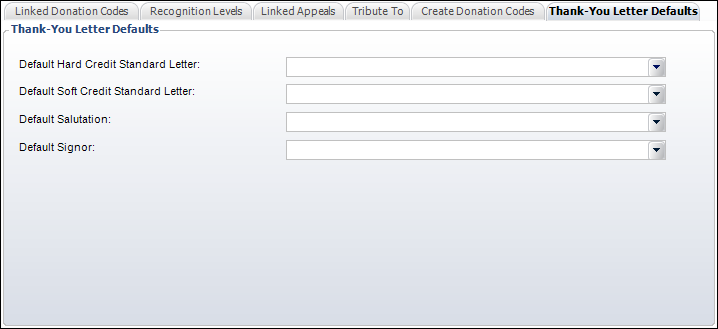
a. Select
the Default Thank You Hard Credit Standard Letter Code
from the drop-down.
This is the letter code for all hard credit acknowledgement merge letters
if this fund is selected for the donation.
b. Select
the Default Thank You Soft Credit Standard Letter Code
from the drop-down.
This is the letter code for all soft credit acknowledgement merge letters
if this fund is selected for the donation.
c. Select the Default Salutation from the drop-down for the selected Letter Code.
d. Select the Default Signor from the drop-down for the selected Letter Code.
18. Click Save.
Screen Element |
Description |
|---|---|
Campaign Definition |
|
Campaign |
Text box. A unique code for the campaign. This code can be associated with products and/or order lines. |
Description |
Text box. The description of the campaign. Maximum length is 50 characters. |
Campaign Class |
Drop-down. The classification of the campaign. This class code can be used for reporting purposes. For example, Capital Campaign, Building Campaign, or Disaster Relief. Values in the drop-down are populated based on the non-fixed codes defined for the FND "CAMPAIGN_CLASS" system type. |
Parent Campaign |
Link. When clicked, the Generic Chooser screen displays where you can search for a parent campaign related to the new campaign. Associating a parent campaign is useful for reporting. |
Active |
Read-only. A new campaign is automatically considered active. The green checkmark indicates the campaign can be linked to funds, appeals, recognition levels, and solicitation teams. Only active campaigns can be selected for a product or an order line. |
Recognition Structure |
Drop-down. Each campaign defines a single recognition structure which itself has a separate structure for each constituent type. For example, institutional givers versus individual givers. The recognition structure defines the level of donations that will receive recognition. Changes to the recognition structure of a campaign only affect future donations, not donations already entered. |
Goal Amount |
Text box. The target amount of money the campaign wants to raise. |
Begin Date |
Drop-down. The start date of the campaign. If a date is entered, the campaign is restricted to donations received on or after a certain date. If an end date is entered as well, the campaign is restricted to donations received between a specific date range. |
End Date |
Drop-down. The last date of the campaign. If this date is entered along with a begin date, the campaign is restricted to donations received between a specific date range. |
Recognition Levels |
|
Edit |
Link. When clicked, the Recognition Structure for Fundraising screen displays where you can edit the recognition level. You can define multiple recognition levels within one structure assigned to a campaign/fund and others across the system for lifetime giving awards. See Defining Recognition Structures for more information. |
Tribute To |
|
Tribute Type |
Drop-down. If this campaign is in tribute to a person, company, or group, select the Tribute Type. For example, In Honor Of or In Memory Of. The acknowledgement letters and campaign summary reports differ based on the code entered here. Values in the drop-down are populated based on the codes defined for the non-fixed FND "TRIBUTE_TYPE" system type. |
Description |
Text box. The description of the tribute. |
Tribute To |
Link. The customer to whom this campaign is a tribute. |
Primary Contact |
Link. The contact for the customer to whom this campaign is a tribute. A campaign donation summary report can be generated for the primary contact. |
Address |
Link. The address of the contact to whom this campaign is a tribute. This address will be used when the campaign summary report is sent to the primary contact. |
Create Donation Codes |
|
Fund |
Link. When clicked, a Chooser displays. Search for and select the appropriate fund associated with the product/gift. |
Cash/Check/CC |
Checkbox. When checked, indicates this product/gift is a flat monetary value paid in cash, check, or a credit card. |
One Year Pledge |
Checkbox. When checked, indicates this product/gift is a one year pledge. |
Amount |
Text box. The amount of the gift or pledge that was given. |
Code can be used after |
Drop-down. The date on which this product is available. |
Create Matching Gift |
Checkbox. When checked, indicates a matching gift will be created for this product/gift. |
Create New Donation Codes |
Button. When clicked, the product/gift is created and a confirmation pop-up displays. If you receive a “Default Rate Code is not set” error message, you must define a default rate code for the Fundraising subsystem using the Rate Structure Maintenance (ORD000) screen. |
Thank You Letter Defaults |
|
Default Thank You Hard Credit Standard Letter Code |
Drop-down. The letter codes that are available for hard credits. |
Default Thank You Soft Credit Standard Letter Code |
Drop-down. The letter codes that are available for soft credits. |
Default Salutation |
Drop-down. The default salutation code for the selected Letter Code. Values are populated based on the non-fixed CUS "CUS_SALUTATION" system type. |
Default Signor |
Drop-down. The default signor code for the selected Letter Code. Values are populated based on the non-fixed FND "ACK_LETTER_SIGNOR" system type. |